地下空间开发与利用
- 格式:doc
- 大小:80.50 KB
- 文档页数:13

工程师土木工程中的地下空间开发与利用地下空间开发与利用是土木工程中一个重要而复杂的领域。
随着城市化进程的不断加速和土地资源的有限性,地下空间作为一种新的开发利用方式,受到越来越多的关注和重视。
本文将探讨地下空间开发与利用在土木工程中的重要性,并介绍相关的技术和实践。
一、地下空间开发的重要性地下空间开发与利用在土木工程中具有重要的意义。
首先,地下空间的开发可以充分利用地下资源,提高土地的利用率。
由于城市土地资源紧张,地下空间的开发可以有效地解决土地使用效益低下的问题。
其次,地下空间的开发可以满足城市功能需求的多样性。
例如,地下商场、地下停车场等设施可以提供便利的服务,并减少地上交通拥堵问题。
再次,地下空间的开发可以应对自然灾害和恶劣气候条件。
地下空间可以作为避难所,减少自然灾害对城市造成的损失,在一定程度上提高城市的安全性。
综上所述,地下空间开发与利用对于城市的可持续发展具有重要的促进作用。
二、地下空间开发与利用的技术与实践1. 地下空间勘察和设计技术地下空间开发的首要任务是进行地下空间的勘察和设计。
地下空间勘察需要运用各种现代地质勘察技术,了解地层结构、地下水位、地下水质等情况,为地下空间的设计提供科学依据。
在地下空间设计过程中,需要充分考虑地下水位、土壤力学性质等因素,并采取相应的结构加固措施,确保地下空间的安全稳定。
2. 地下空间施工技术地下空间的施工是一个复杂而精细的过程。
常见的地下空间施工方法包括盖挖结合法、顶管法、施工坑法等。
在施工过程中,需要合理选择施工方法,采取相应的安全防护措施,确保施工过程的安全性和高效性。
3. 地下空间利用的技术与实践地下空间的利用方式多种多样,例如地下商场、地下停车场、地下仓库等。
在地下空间利用过程中,需要考虑通风、照明、消防等设施的设置,确保地下空间的使用质量和安全性。
同时,地下空间利用也需要考虑与地上空间的衔接,形成完整的城市功能体系。
三、地下空间开发与利用的案例1. 地下商场地下商场是一种常见的地下空间利用形式,可以有效解决城市商业区土地紧缺的问题。

城市公交停车场的地下空间开发与利用随着城市化进程的加快,城市公共交通系统的发展成为了改善居民出行环境的重要举措。
在城市中,公交车是繁忙人群的重要出行方式之一,而公交停车场则是保证公交车正常运营的重要基础设施。
然而,为了充分利用有限的城市土地资源,城市公交停车场的地下空间开发与利用也逐渐成为了城市规划者和发展商关注的焦点。
地下空间开发是指将地下区域合理利用起来,提高城市土地的综合利用率。
对于城市公交停车场而言,地下空间开发可以分为两个方面:一是利用停车场下方的地下空间进行商业开发;二是将停车场本身设置在地下层,以节省地面土地资源。
首先,利用停车场下方的地下空间进行商业开发可以最大程度地提高土地价值。
在设立公交停车场时,通常会在其下方预留一定的地下空间,用于商业开发。
这些地下空间可以设立商场、超市、餐饮等各类商业设施,为居民提供便利的购物体验。
此外,还可以建设娱乐设施、体育设施等,丰富居民的休闲娱乐生活。
通过将地下空间充分利用起来,不仅可以提高土地的综合利用效率,还可以为城市的商业发展带来新的机遇。
其次,将公交停车场设置在地下层,可以节约地面土地资源。
随着城市人口的增加和私家车的普及,对停车场的需求也越来越高。
然而,地面土地资源却有限,无法满足越来越多的停车需求。
因此,将公交停车场设置在地下层可以解决这一问题。
通过将停车场下沉至地下,可以有效节约地面土地资源并提高城市道路的通行能力。
同时,地下停车场还可以减少交通拥堵和尾气排放,改善城市的交通环境。
但是,城市公交停车场的地下空间开发与利用也面临一些挑战。
首先是技术挑战。
地下空间的开发和利用需要很高的技术水平和设备投入。
例如,地下停车场需要专业的通风、照明和消防设备。
此外,地下空间的开发需要考虑地下水位和地质条件,以确保工程的安全性。
其次是资金问题。
地下空间的开发投资较大,需要政府和企业共同承担。
为了实现地下空间的开发利用,政府需要提供相应的政策和资金支持,同时鼓励企业参与其中。
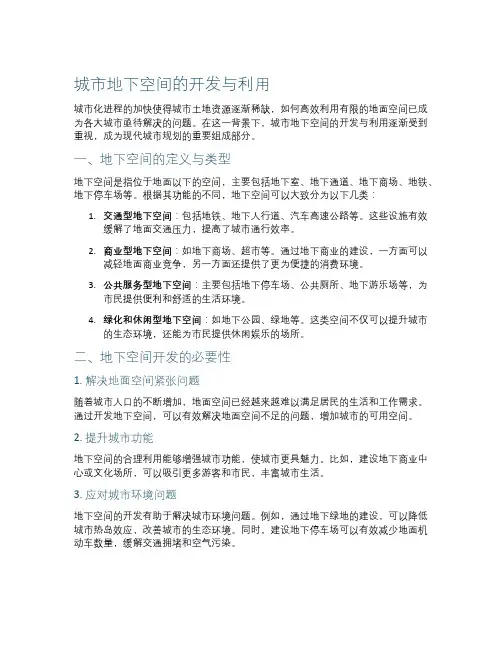
城市地下空间的开发与利用城市化进程的加快使得城市土地资源逐渐稀缺,如何高效利用有限的地面空间已成为各大城市亟待解决的问题。
在这一背景下,城市地下空间的开发与利用逐渐受到重视,成为现代城市规划的重要组成部分。
一、地下空间的定义与类型地下空间是指位于地面以下的空间,主要包括地下室、地下通道、地下商场、地铁、地下停车场等。
根据其功能的不同,地下空间可以大致分为以下几类:1.交通型地下空间:包括地铁、地下人行道、汽车高速公路等。
这些设施有效缓解了地面交通压力,提高了城市通行效率。
2.商业型地下空间:如地下商场、超市等。
通过地下商业的建设,一方面可以减轻地面商业竞争,另一方面还提供了更为便捷的消费环境。
3.公共服务型地下空间:主要包括地下停车场、公共厕所、地下游乐场等,为市民提供便利和舒适的生活环境。
4.绿化和休闲型地下空间:如地下公园、绿地等。
这类空间不仅可以提升城市的生态环境,还能为市民提供休闲娱乐的场所。
二、地下空间开发的必要性1. 解决地面空间紧张问题随着城市人口的不断增加,地面空间已经越来越难以满足居民的生活和工作需求。
通过开发地下空间,可以有效解决地面空间不足的问题,增加城市的可用空间。
2. 提升城市功能地下空间的合理利用能够增强城市功能,使城市更具魅力。
比如,建设地下商业中心或文化场所,可以吸引更多游客和市民,丰富城市生活。
3. 应对城市环境问题地下空间的开发有助于解决城市环境问题。
例如,通过地下绿地的建设,可以降低城市热岛效应,改善城市的生态环境。
同时,建设地下停车场可以有效减少地面机动车数量,缓解交通拥堵和空气污染。
三、地下空间开发的挑战尽管地下空间开发带来诸多好处,但在实际操作中也面临一些挑战:1. 成本问题地下开发的成本通常高于地上开发,涉及到土建、水电、通风、排水系统等多个方面的投资。
同时,地下空间的回报周期较长,决策者需谨慎评估项目的可行性。
2. 地质条件的复杂性城市地下的地质条件复杂多变,可能存在软土、地下水、岩层等问题,这为地下空间的开发和施工带来困难。
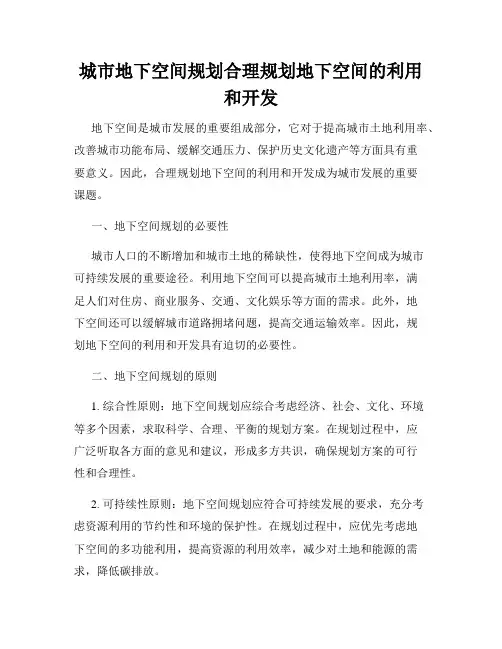
城市地下空间规划合理规划地下空间的利用和开发地下空间是城市发展的重要组成部分,它对于提高城市土地利用率、改善城市功能布局、缓解交通压力、保护历史文化遗产等方面具有重要意义。
因此,合理规划地下空间的利用和开发成为城市发展的重要课题。
一、地下空间规划的必要性城市人口的不断增加和城市土地的稀缺性,使得地下空间成为城市可持续发展的重要途径。
利用地下空间可以提高城市土地利用率,满足人们对住房、商业服务、交通、文化娱乐等方面的需求。
此外,地下空间还可以缓解城市道路拥堵问题,提高交通运输效率。
因此,规划地下空间的利用和开发具有迫切的必要性。
二、地下空间规划的原则1. 综合性原则:地下空间规划应综合考虑经济、社会、文化、环境等多个因素,求取科学、合理、平衡的规划方案。
在规划过程中,应广泛听取各方面的意见和建议,形成多方共识,确保规划方案的可行性和合理性。
2. 可持续性原则:地下空间规划应符合可持续发展的要求,充分考虑资源利用的节约性和环境的保护性。
在规划过程中,应优先考虑地下空间的多功能利用,提高资源的利用效率,减少对土地和能源的需求,降低碳排放。
3. 安全性原则:地下空间规划应以安全为前提,确保地下建设的安全可靠。
在规划过程中,应进行地质勘探和风险评估,合理规划地下空间的深度、面积和结构,采取科学的设计和建设措施,保障地下空间的使用安全。
三、地下空间的合理利用和开发1. 交通场所:地下空间可用于建设地铁、轻轨站点、公交车站等交通设施,缓解城市交通压力,提高交通效率。
同时,地下空间可以规划为停车场,解决城市停车难的问题。
2. 商业服务场所:地下空间可用于商场、超市、餐饮店等商业设施的建设,丰富城市商业体系,提升购物和消费体验。
3. 文化娱乐场所:地下空间可用于建设博物馆、图书馆、美术馆、演艺中心等文化设施,满足人们对文化娱乐的需求,丰富城市文化生活。
4. 公共服务场所:地下空间可用于建设医院、学校、体育馆等公共服务设施,提供优质的公共服务,改善城市民生。
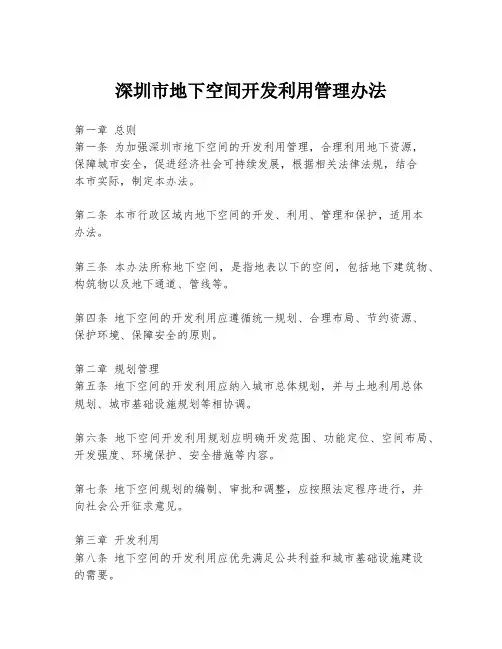
深圳市地下空间开发利用管理办法第一章总则第一条为加强深圳市地下空间的开发利用管理,合理利用地下资源,保障城市安全,促进经济社会可持续发展,根据相关法律法规,结合本市实际,制定本办法。
第二条本市行政区域内地下空间的开发、利用、管理和保护,适用本办法。
第三条本办法所称地下空间,是指地表以下的空间,包括地下建筑物、构筑物以及地下通道、管线等。
第四条地下空间的开发利用应遵循统一规划、合理布局、节约资源、保护环境、保障安全的原则。
第二章规划管理第五条地下空间的开发利用应纳入城市总体规划,并与土地利用总体规划、城市基础设施规划等相协调。
第六条地下空间开发利用规划应明确开发范围、功能定位、空间布局、开发强度、环境保护、安全措施等内容。
第七条地下空间规划的编制、审批和调整,应按照法定程序进行,并向社会公开征求意见。
第三章开发利用第八条地下空间的开发利用应优先满足公共利益和城市基础设施建设的需要。
第九条地下空间的开发利用应符合土地使用权出让合同的约定,并依法办理相关审批手续。
第十条地下空间开发项目应进行环境影响评价,并采取有效措施,减少对环境的影响。
第十一条地下空间的开发利用应符合安全标准,建立健全安全管理制度,确保人员和财产安全。
第四章产权管理第十二条地下空间的产权归属应依法确定,产权人享有使用、收益、处分的权利,并承担相应的义务。
第十三条地下空间的产权转让、出租、抵押等,应依法办理相关手续。
第十四条地下空间的产权登记,应按照不动产登记的相关规定执行。
第五章监督管理第十五条市、区人民政府应加强对地下空间开发利用的监督管理,确保本办法的实施。
第十六条地下空间开发利用的监督检查应定期进行,对违法行为依法予以查处。
第十七条任何单位和个人有权对地下空间开发利用中的违法行为进行举报,相关部门应及时处理。
第六章法律责任第十八条违反本办法规定,未依法办理审批手续擅自开发利用地下空间的,由相关部门责令停止违法行为,限期改正,并可处以罚款。
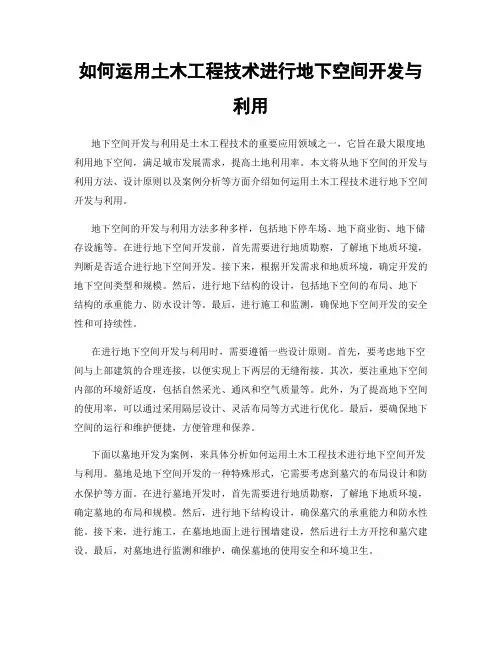
如何运用土木工程技术进行地下空间开发与利用地下空间开发与利用是土木工程技术的重要应用领域之一,它旨在最大限度地利用地下空间,满足城市发展需求,提高土地利用率。
本文将从地下空间的开发与利用方法、设计原则以及案例分析等方面介绍如何运用土木工程技术进行地下空间开发与利用。
地下空间的开发与利用方法多种多样,包括地下停车场、地下商业街、地下储存设施等。
在进行地下空间开发前,首先需要进行地质勘察,了解地下地质环境,判断是否适合进行地下空间开发。
接下来,根据开发需求和地质环境,确定开发的地下空间类型和规模。
然后,进行地下结构的设计,包括地下空间的布局、地下结构的承重能力、防水设计等。
最后,进行施工和监测,确保地下空间开发的安全性和可持续性。
在进行地下空间开发与利用时,需要遵循一些设计原则。
首先,要考虑地下空间与上部建筑的合理连接,以便实现上下两层的无缝衔接。
其次,要注重地下空间内部的环境舒适度,包括自然采光、通风和空气质量等。
此外,为了提高地下空间的使用率,可以通过采用隔层设计、灵活布局等方式进行优化。
最后,要确保地下空间的运行和维护便捷,方便管理和保养。
下面以墓地开发为案例,来具体分析如何运用土木工程技术进行地下空间开发与利用。
墓地是地下空间开发的一种特殊形式,它需要考虑到墓穴的布局设计和防水保护等方面。
在进行墓地开发时,首先需要进行地质勘察,了解地下地质环境,确定墓地的布局和规模。
然后,进行地下结构设计,确保墓穴的承重能力和防水性能。
接下来,进行施工,在墓地地面上进行围墙建设,然后进行土方开挖和墓穴建设。
最后,对墓地进行监测和维护,确保墓地的使用安全和环境卫生。
通过这个案例,可以看出地下空间的开发与利用是一个综合性的工程项目,需要结合地质、结构、施工等方面进行综合考虑。
同时,还需要关注地下空间的环境舒适度、使用便捷性以及安全性等方面。
通过合理的设计和严格的施工监督,可以有效地进行地下空间开发与利用,为城市发展提供更多的发展空间。
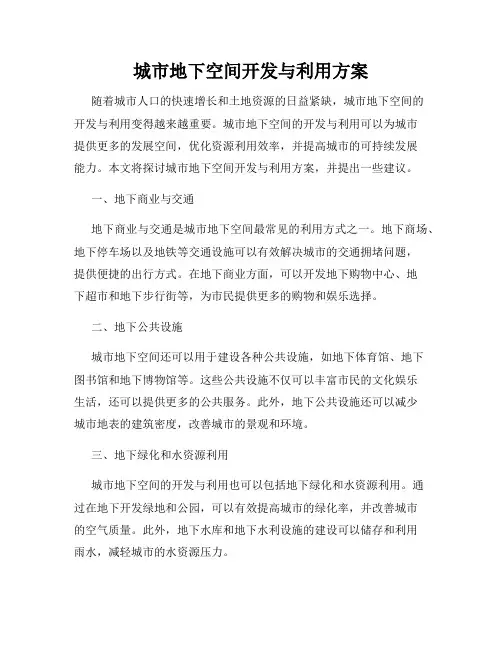
城市地下空间开发与利用方案随着城市人口的快速增长和土地资源的日益紧缺,城市地下空间的开发与利用变得越来越重要。
城市地下空间的开发与利用可以为城市提供更多的发展空间,优化资源利用效率,并提高城市的可持续发展能力。
本文将探讨城市地下空间开发与利用方案,并提出一些建议。
一、地下商业与交通地下商业与交通是城市地下空间最常见的利用方式之一。
地下商场、地下停车场以及地铁等交通设施可以有效解决城市的交通拥堵问题,提供便捷的出行方式。
在地下商业方面,可以开发地下购物中心、地下超市和地下步行街等,为市民提供更多的购物和娱乐选择。
二、地下公共设施城市地下空间还可以用于建设各种公共设施,如地下体育馆、地下图书馆和地下博物馆等。
这些公共设施不仅可以丰富市民的文化娱乐生活,还可以提供更多的公共服务。
此外,地下公共设施还可以减少城市地表的建筑密度,改善城市的景观和环境。
三、地下绿化和水资源利用城市地下空间的开发与利用也可以包括地下绿化和水资源利用。
通过在地下开发绿地和公园,可以有效提高城市的绿化率,并改善城市的空气质量。
此外,地下水库和地下水利设施的建设可以储存和利用雨水,减轻城市的水资源压力。
四、地下能源利用随着能源需求的增加和传统能源的有限性,地下能源利用成为一种新的发展趋势。
地下热泵、地下冷暖库以及地下能源站等设施可以有效利用地下的温度差异,实现能源的高效利用。
这不仅可以提供城市的能源需求,还可以减少对传统能源的依赖,降低能源消耗和碳排放。
五、地下文化遗产保护与利用城市地下空间中还隐藏着丰富的文化遗产资源,如古老的地下城市、地下宫殿和地下墓葬等。
保护和利用这些地下文化遗产可以丰富城市的历史文化底蕴,并吸引更多的游客和文化爱好者。
同时,地下文化遗产的开发利用也可以为城市的经济发展带来新的机遇。
六、地下垃圾处理城市地下空间还可以用于垃圾处理和回收利用。
地下垃圾处理站和地下垃圾分类设施可以有效减少城市垃圾对环境的污染,并提高垃圾资源的回收利用率。
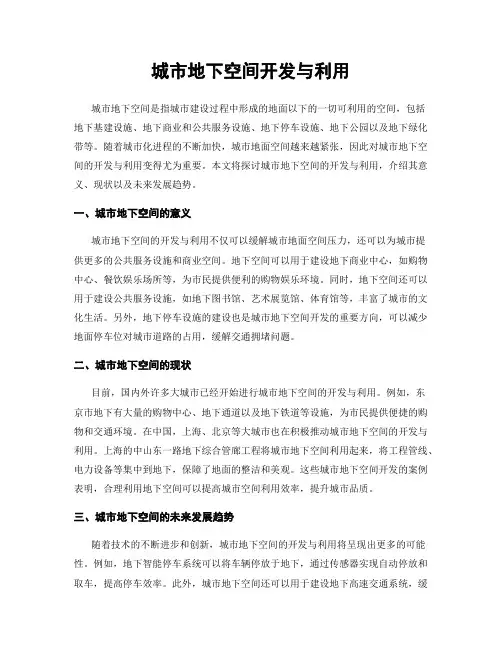
城市地下空间开发与利用城市地下空间是指城市建设过程中形成的地面以下的一切可利用的空间,包括地下基建设施、地下商业和公共服务设施、地下停车设施、地下公园以及地下绿化带等。
随着城市化进程的不断加快,城市地面空间越来越紧张,因此对城市地下空间的开发与利用变得尤为重要。
本文将探讨城市地下空间的开发与利用,介绍其意义、现状以及未来发展趋势。
一、城市地下空间的意义城市地下空间的开发与利用不仅可以缓解城市地面空间压力,还可以为城市提供更多的公共服务设施和商业空间。
地下空间可以用于建设地下商业中心,如购物中心、餐饮娱乐场所等,为市民提供便利的购物娱乐环境。
同时,地下空间还可以用于建设公共服务设施,如地下图书馆、艺术展览馆、体育馆等,丰富了城市的文化生活。
另外,地下停车设施的建设也是城市地下空间开发的重要方向,可以减少地面停车位对城市道路的占用,缓解交通拥堵问题。
二、城市地下空间的现状目前,国内外许多大城市已经开始进行城市地下空间的开发与利用。
例如,东京市地下有大量的购物中心、地下通道以及地下铁道等设施,为市民提供便捷的购物和交通环境。
在中国,上海、北京等大城市也在积极推动城市地下空间的开发与利用。
上海的中山东一路地下综合管廊工程将城市地下空间利用起来,将工程管线、电力设备等集中到地下,保障了地面的整洁和美观。
这些城市地下空间开发的案例表明,合理利用地下空间可以提高城市空间利用效率,提升城市品质。
三、城市地下空间的未来发展趋势随着技术的不断进步和创新,城市地下空间的开发与利用将呈现出更多的可能性。
例如,地下智能停车系统可以将车辆停放于地下,通过传感器实现自动停放和取车,提高停车效率。
此外,城市地下空间还可以用于建设地下高速交通系统,缓解城市交通拥堵问题。
地下光伏发电装置的应用也是未来城市地下空间开发的重要方向,利用太阳能发电可以为城市提供可再生能源,降低碳排放。
结语城市地下空间的开发与利用是城市化进程中的重要问题,对缓解城市地面空间压力、提升城市品质具有重要意义。
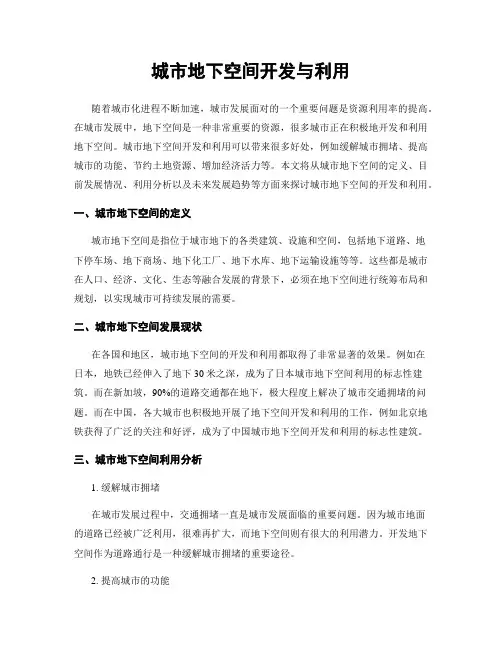
城市地下空间开发与利用随着城市化进程不断加速,城市发展面对的一个重要问题是资源利用率的提高。
在城市发展中,地下空间是一种非常重要的资源,很多城市正在积极地开发和利用地下空间。
城市地下空间开发和利用可以带来很多好处,例如缓解城市拥堵、提高城市的功能、节约土地资源、增加经济活力等。
本文将从城市地下空间的定义、目前发展情况、利用分析以及未来发展趋势等方面来探讨城市地下空间的开发和利用。
一、城市地下空间的定义城市地下空间是指位于城市地下的各类建筑、设施和空间,包括地下道路、地下停车场、地下商场、地下化工厂、地下水库、地下运输设施等等。
这些都是城市在人口、经济、文化、生态等融合发展的背景下,必须在地下空间进行统筹布局和规划,以实现城市可持续发展的需要。
二、城市地下空间发展现状在各国和地区,城市地下空间的开发和利用都取得了非常显著的效果。
例如在日本,地铁已经伸入了地下30米之深,成为了日本城市地下空间利用的标志性建筑。
而在新加坡,90%的道路交通都在地下,极大程度上解决了城市交通拥堵的问题。
而在中国,各大城市也积极地开展了地下空间开发和利用的工作,例如北京地铁获得了广泛的关注和好评,成为了中国城市地下空间开发和利用的标志性建筑。
三、城市地下空间利用分析1. 缓解城市拥堵在城市发展过程中,交通拥堵一直是城市发展面临的重要问题。
因为城市地面的道路已经被广泛利用,很难再扩大,而地下空间则有很大的利用潜力。
开发地下空间作为道路通行是一种缓解城市拥堵的重要途径。
2. 提高城市的功能城市地下空间的开发不仅可以缓解交通拥堵,还可以提高城市的功能。
例如地下商场、地下超市、地下美食街等,都可以带动城市消费的繁荣发展,提高城市的商业和文化吸引力。
3. 节约土地资源城市地面有限,开发地下空间可以充分利用城市的土地资源,节约了地面的空间限制。
这样,就可以在城市规模和功能的基础上,增加城市的密度和利用率。
4. 增加经济活力城市地下空间的利用可以带来一定的经济效益。
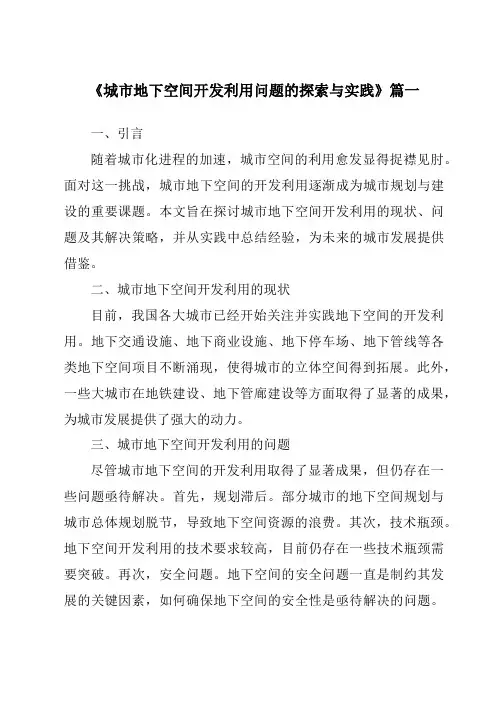
《城市地下空间开发利用问题的探索与实践》篇一一、引言随着城市化进程的加速,城市空间的利用愈发显得捉襟见肘。
面对这一挑战,城市地下空间的开发利用逐渐成为城市规划与建设的重要课题。
本文旨在探讨城市地下空间开发利用的现状、问题及其解决策略,并从实践中总结经验,为未来的城市发展提供借鉴。
二、城市地下空间开发利用的现状目前,我国各大城市已经开始关注并实践地下空间的开发利用。
地下交通设施、地下商业设施、地下停车场、地下管线等各类地下空间项目不断涌现,使得城市的立体空间得到拓展。
此外,一些大城市在地铁建设、地下管廊建设等方面取得了显著的成果,为城市发展提供了强大的动力。
三、城市地下空间开发利用的问题尽管城市地下空间的开发利用取得了显著成果,但仍存在一些问题亟待解决。
首先,规划滞后。
部分城市的地下空间规划与城市总体规划脱节,导致地下空间资源的浪费。
其次,技术瓶颈。
地下空间开发利用的技术要求较高,目前仍存在一些技术瓶颈需要突破。
再次,安全问题。
地下空间的安全问题一直是制约其发展的关键因素,如何确保地下空间的安全性是亟待解决的问题。
最后,资金投入不足。
地下空间的开发利用需要大量的资金投入,但目前政府和企业在这方面投入的力度还远远不够。
四、解决策略针对上述问题,本文提出以下解决策略:1. 加强规划引领。
将地下空间规划纳入城市总体规划,确保地下空间资源的合理配置。
2. 突破技术瓶颈。
加大科研投入,引进先进技术,提高地下空间开发利用的技术水平。
3. 强化安全管理。
建立健全的地下空间安全管理制度,确保地下空间的安全性。
4. 增加资金投入。
政府应加大对地下空间开发利用的投入力度,同时吸引更多企业参与其中。
五、实践探索以某大城市地铁建设为例,该市在地铁建设中充分考虑了地下空间的综合利用。
首先,在规划阶段,将地铁线路与城市总体规划相结合,确保地铁建设的合理性。
其次,在技术方面,引进先进的施工技术和设备,提高施工效率和质量。
同时,注重地铁沿线地下空间的综合利用,如建设地下商业设施、地下停车场等,提高土地利用率。

地下空间在城市规划中的利用与开发城市发展过程中,土地资源的有限性是一个不容忽视的问题。
在这种情况下,地下空间的利用和开发变得尤为重要。
地下空间,作为一种相对不受限制的资源,可以用于承载各种城市功能和服务,从而为城市的可持续发展提供支持。
本文将探讨地下空间在城市规划中的利用与开发,并重点关注其应用于交通、商业和环境保护领域的潜力。
首先,地下空间在交通领域的利用与开发具有重要意义。
随着城市人口的不断增长和车辆数量的剧增,传统的地面交通系统已经无法满足需求。
因此,地下交通系统的建设成为了改善城市交通状况的重要手段。
地下道路、地下铁路和地下停车场等设施的建设,可以有效减缓城市交通拥堵问题,提高交通效率和人民出行的便利性。
此外,由于地下空间的隔离性,地铁系统的建设可以减少噪音和尾气的污染,改善城市环境品质。
其次,地下空间在商业领域的利用与开发也具有巨大潜力。
传统上,城市的商业活动主要集中在地面建筑物中,导致了土地资源的极度浪费。
然而,地下空间可以成为商业发展的新的增长点。
如今,越来越多的地下商场、地下商铺和地下娱乐场所在城市中涌现。
这些地下商业空间不仅节约了土地资源,还为消费者提供了全新的购物和娱乐体验。
此外,地下空间的低温和稳定的湿度也使其成为冷库和文物保护设施的理想选择。
此外,地下空间在环境保护领域的利用与开发也具有重要意义。
随着城市化进程的加快,土地覆盖率上升,导致城市热岛效应的加剧。
而地下空间的利用可以起到一定的缓解作用。
地下绿化、地下湖泊和地下水库等设施的建设,可以有效降低城市的气温、改善空气质量,提供良好的生态环境。
此外,通过地下水冷却系统的应用,可以减少空调系统的使用,降低能源消耗,从而实现环境可持续发展的目标。
综上所述,地下空间的利用与开发在城市规划中具有重要意义。
它不仅可以提高城市交通效率和便利性,还可以节约土地资源,并为商业发展和环境保护提供新的机遇。
然而,地下空间的利用和开发也面临着诸多挑战,如地质条件、工程技术和投资成本等问题。
土木工程中的地下空间开发与利用地下空间是土木工程中关键而又潜力巨大的资源。
随着城市化进程的不断加快和土地资源的有限性,地下空间的开发与利用成为了人们关注的焦点。
本文将从地下空间的优势、开发方法以及应用领域等方面进行探讨。
一、地下空间的优势地下空间相对于地上空间具有以下几方面的优势。
首先,地下空间可以充分利用有限的土地资源。
随着人口的不断增加和城市用地的紧张,地面上的土地已经十分有限。
而地下空间的开发可以充分利用地下空间,解决土地资源稀缺的问题。
其次,地下空间能够有效缓解城市交通拥堵。
随着城市化进程的不断加快,城市交通面临着前所未有的挑战。
而地下空间的开发可以用于建设地下交通网络,分流地上道路交通流量,缓解交通拥堵。
再次,地下空间在抗灾减灾方面具有独特的优势。
地下空间可以作为指挥中心、避难所等设施,在自然灾害发生时发挥重要作用,可以保障人民的生命财产安全。
最后,地下空间是一种环境友好型的开发方式。
地下空间的开发不会对地表环境产生负面影响,有利于保护城市生态环境。
二、地下空间的开发方法地下空间的开发与利用需要考虑到土质条件、工程技术、经济可行性等因素。
以下是几种常见的地下空间开发方法。
1. 地下车库地下车库是地下空间开发的常见形式之一。
通过将停车场设施建设在地下,可以有效缓解地面停车位不足的问题,提高城市停车资源的利用率。
2. 地下商场地下商场是以商业经营为目标,将商场或购物中心设立在地下的一种开发方式。
地下商场可以满足人们购物需求,同时减少地上商业用地的占用。
3. 地下交通网络地下交通网络是利用地下空间开展交通运输的一种方式。
通过建设地铁、地下隧道等交通设施,可以分流地上交通流量,缓解交通拥堵。
4. 地下公共设施地下公共设施包括地下管网、地下文化设施、地下体育场馆等。
这些设施的建设可以充分利用地下空间,提高城市基础设施的综合效益。
三、地下空间的应用领域地下空间的开发与利用可以应用于多个领域。
1. 城市规划在城市规划中,可以利用地下空间来规划道路、交通设施、公园绿地等,来提高城市的整体使用效益。
高层建筑中的地下空间开发与利用随着城市化进程不断加快,土地资源越发紧张,对于建筑空间的利用也提出了更高的要求。
在高层建筑中,地下空间的开发与利用变得越来越重要。
本文将探讨高层建筑中地下空间的发展趋势与利用价值,并提出相关建议。
一、地下空间开发的必要性1. 土地资源的有限性城市的土地资源愈发紧张,而高层建筑往往需要占用大量地上空间,导致限制了建设的规模和发展。
地下空间的合理开发可以从根本上解决建筑空间不足的问题。
2. 地下空间的潜力地下空间利用率低,往往被忽视,但其潜力巨大。
地下空间可以灵活运用于商业、文化、交通、储存、排水等方面,为城市功能的完善提供了更多可能。
二、高层建筑地下空间的利用方式1. 设立物流中心高层建筑下方的地下空间可用于建设物流中心,可以将货物的收发、仓储等环节集中在地下空间中,提高物流效率,减少地上交通堵塞。
2. 建设地下购物中心地下空间可以作为购物中心的一部分,满足市民购物需求,减少地上商铺的竞争,提供更为安静、舒适的购物环境。
地下购物中心同时还能避免恶劣天气对购物活动的影响。
3. 打造地下停车场高层建筑常常面临停车位不足的问题,地下空间可以作为停车场的解决方案。
地下停车场容量大,不仅可以满足建筑内部停车需求,还可以为周边地区提供停车位。
4. 建设文化娱乐设施地下空间可用于建设电影院、博物馆、展览馆等文化娱乐设施,提供人们的休闲娱乐场所。
这不仅拓宽了城市文化活动的空间,还为市民提供了广阔的文化体验。
5. 构建地下交通网络高层建筑的地下空间可作为地铁、交通枢纽等交通基础设施的一部分。
地下的交通网络可以方便地与地上交通衔接,更好地解决城市交通拥堵问题。
三、相关问题与建议1. 地下空间规划与设计在高层建筑设计之初,就应将地下空间纳入规划范围。
需要充分考虑地下空间的承重、通风、照明等问题,通过合理规划,确保地下空间的安全可靠,并使其与地上空间紧密结合。
2. 地下空间的安全问题地下空间开发需要充分考虑安全问题,包括逃生通道设置、防火措施、安全监控等。
岩土工程中的地下空间开发与利用地下空间开发与利用是岩土工程领域的重要内容之一。
地下空间的合理规划与利用,在促进城市可持续发展、提高土地利用率、改善居住环境等方面扮演着重要角色。
本文将就地下空间开发与利用的背景、岩土工程技术在地下空间开发中的应用、地下空间利用的技术和案例等方面进行阐述。
一、地下空间开发与利用的背景地下空间指的是地表以下用于各种目的的空间。
由于城市化进程的快速发展,土地资源日益稀缺,而地下空间则成为扩大城市发展空间的重要手段。
地下空间可以被广泛应用于交通、商业、文化、生活等多个领域。
地下空间的规划与利用需要借助岩土工程技术,以确保地下空间的安全性和可持续性。
二、岩土工程技术在地下空间开发中的应用1. 地下空间勘察与分析技术开发地下空间前需要进行地质勘察和地下水勘察,并对岩土工程环境进行评估。
通过勘察和分析,可以确定地下空间的适用性、可行性和风险性,为后续的开发工作提供数据支持。
2. 地下空间设计与施工技术地下空间的设计与施工需要考虑地下水位、地下岩土层、地震力等因素。
岩土工程技术可以为地下结构的设计提供支持,确保结构的稳定性和安全性。
施工时需要采用合适的地下工程技术,如隧道掘进、地下室开挖等。
三、地下空间利用的技术和案例1. 地下交通地下交通是地下空间开发的重要组成部分。
在繁忙的城市中,地下交通可以缓解地面交通压力,提高交通效率。
岩土工程技术在地下交通的设计和施工中起到关键作用,如隧道工程的应用。
2. 地下商业地下商业是一种创新的商业模式,可以通过开设商场、超市、餐厅等商业设施在地下空间进行经营。
利用地下空间开展商业活动可以增加土地利用率,提高商业发展的灵活性。
岩土工程技术在地下商业的规划、设计和施工中发挥重要作用,如地下停车场的建设。
3. 地下文化地下空间还可以用于举办展览、博物馆、音乐会等文化活动。
利用地下空间开展文化活动可以丰富城市文化生活,提高文化的普及率。
岩土工程技术在地下文化设施的建设中发挥重要作用,如地下展览馆的设计和施工。
建筑物的地下空间开发与利用地下空间是指建筑物地下的一切空间,包括地下室、地下停车场、地下商业等。
在城市建设和规划中,地下空间的合理开发和利用可以达到提高土地利用效率、缓解城市交通压力、改善城市生活环境等目的。
本文将探讨建筑物地下空间的开发与利用。
1. 地下空间的开发方式地下空间的开发方式多种多样,可根据具体需求和地质条件进行选择。
一般常见的地下空间开发方式有以下几种:1.1 地下室地下室是地下建筑的一种常见形式,通常位于建筑物的地下一层或地下两层,用于储存、设备放置、住宅等多种功能。
地下室的开发可以有效扩大建筑物的使用面积,提高土地的利用效率。
1.2 地下停车场地下停车场是城市交通建设中常用的地下空间利用方式,通过将停车场设施建设在地下,可以节省地上的空间,减少地面交通堵塞,改善城市交通状况。
1.3 地下商业地下商业是在地下开设商铺、购物中心等商业设施,通过将商业活动下沉,可以有效利用地下空间,缓解地面商业压力,提高城市商业的多样性和供给能力。
2. 地下空间利用的优势地下空间利用有着诸多优势,对城市的发展和居民生活都具有重要意义。
2.1 提高土地利用效率城市土地是有限的资源,通过合理利用地下空间,可以充分发挥土地的潜力,提高土地的使用效率。
尤其是在土地成本高昂的城市中,地下空间的开发利用成为一种重要的解决方案。
2.2 缓解城市交通压力地下停车场的建设可以有效减少地面停车位的需求,缓解城市交通压力。
此外,地下通道的建设也可以改善城市的交通状况,提高交通效率。
2.3 改善城市生活环境通过将商业、娱乐等活动下沉到地下,可以减少地面商业的集中度,改善城市的生活环境。
地下空间还可以用于建设文化设施、公共服务设施等,提供更多的公共空间供市民使用。
3. 地下空间开发与利用的挑战虽然地下空间开发与利用有着诸多优势,但也面临着一些挑战。
3.1 地下环境的复杂性地下空间的开发需要考虑地质条件、地下水位、岩性等多种因素,这些因素对地下空间的设计和施工都有较高的要求。
《城市地下空间开发利用问题的探索与实践》篇一一、引言随着城市化进程的不断加速,城市空间的开发利用已进入了一个全新的阶段。
其中,城市地下空间的开发利用成为了解决城市发展问题的重要途径之一。
本文旨在探索城市地下空间开发利用的实践与问题,以期为未来城市规划与发展提供参考。
二、城市地下空间开发利用的背景与意义城市地下空间作为一种新的发展领域,具有承载城市交通、环境、资源等多种功能的特点。
开发利用地下空间不仅能够解决城市交通拥堵、环境保护等实际问题,还能够有效缓解城市土地资源紧张的压力,实现城市立体化、多层次发展。
三、当前城市地下空间开发利用的现状当前,我国各大城市正积极开展地下空间开发利用的探索与实践。
一方面,地下交通设施如地铁、地下通道等不断涌现,极大地缓解了地面交通压力;另一方面,地下商业设施、地下能源储备等项目也取得了显著的成果。
然而,在开发过程中也暴露出一些问题,如技术难题、资金投入大、规划与建设协调困难等。
四、存在的问题及分析(一)技术难题随着地下空间开发的深入,技术难题逐渐凸显。
如地下空间环境复杂多变,对施工技术和设备要求较高;同时,地下空间地质条件多变,对工程安全与稳定性提出了更高的要求。
(二)资金投入大地下空间开发需要大量的资金投入,包括基础设施建设、设备购置、人员培训等。
在资金来源和投入方面存在较大的困难。
(三)规划与建设协调困难由于地下空间规划与城市总体规划的协调性不足,导致在实际建设中出现了一系列问题,如项目重复建设、资源浪费等。
五、实践探索与对策建议(一)加强技术研发与创新针对技术难题,应加强技术研发与创新,引进先进的施工技术和设备,提高地下空间开发的效率和安全性。
同时,应加强对地下空间环境的监测与保护,确保工程安全与稳定性。
(二)多元化资金筹措机制针对资金投入大的问题,应建立多元化的资金筹措机制,包括政府投资、企业投资、社会资本参与等多种方式。
同时,应加强对资金使用的监管和管理,确保资金的有效利用。
地下空间资源的综合开发与利用随着城市化的不断加速,城市土地的资源利用面临着瓶颈,同时城市建设对于土地资源的开发需求也日益增长。
因此,地下空间资源的综合开发与利用已经成为了一个备受瞩目的话题。
地下空间资源指的是在地下深度范围内可利用的土地资源,如地下商场、地下停车场、地下热电站等。
地下空间的利用具有显著的优势,一方面可以缓解现今城市面临的土地紧张问题,另一方面也可以降低城市建设所需的成本和对自然环境的影响。
然而,地下空间资源的开发与利用也面临着种种挑战。
一方面,地下的环境条件和工程难度都比较复杂,需要更高的技术和经验;另一方面,需要对地下空间资源进行统筹规划,避免资源浪费和冲突,从而实现资源的最优化利用。
在开发和利用地下空间资源时,需要首先进行全面系统的规划。
地下空间规划需要充分考虑利用现有建筑、道路和管道等基础设施的条件,同时还需考虑人口、交通、环保和景观等问题。
地下空间规划需要协调相关部门和企业的利益关系,保证资源的可持续利用和发展能力。
除了规划以外,地下空间资源的开发和利用还需要通过科技创新来推进。
例如,基于互联网和物联网技术,可以实现地下空间资源的智能化管理和监控,从而增强其安全性和可靠性;基于新能源科技,还可以实现地下空间的绿色能源开发,为城市可持续发展奠定基础。
此外,地下空间资源的开发和利用也需要符合法律法规和社会道德标准。
需要注重环境保护和资源节约,同时还需要遵守建设工程的安全和规范标准,保证公共安全和人身安全。
综上所述,地下空间资源的综合开发与利用需要全面系统的规划、科技创新和法律法规的保障。
只有通过合理利用和保护地下空间资源,才能为城市的可持续发展和人民的生活质量提供更加优质的土地资源。
地下空间开发与利用 陈孝琼 15120992 隧道1507班
摘要 地下空间作为一种宝贵的自然资源,世界上许多国家都在对它进行有序、合理、经济、高效的开发和利用,将其广泛应用于交通仓储、防空、环保、能源、居住、商业等领域。 近年来,随着城市经济迅猛发展,社会生产力不断提高,人们对城市发展的 需求也不断增加,此时地下空间资源应运而生,成为解决现代城市问题、促进城市可持续发展的重要手段。地下空间的重点开发地区为地铁线路及车站、城市主干道及交叉点、中心广场(绿地)、商业中心、大型居住区及大型公共设施等。城市以地铁线路为坐标轴线来开发地下空间,能够带动地铁周边地区的发展,通过地铁集聚的巨大人流,吸引更多的投资和建设,有利于调整城市的整体结构。 本文将在杭州市的地下空间开发与利用的既有基础上,分析地下空间开发和利用的特点,同时结合国内外其他其案例,提出自己的一些观点和建议。
关键词 城市地下空间 特点 Abstract Underground space as a kind of precious natural resources, many countries all over the world to it in the orderly, rational, economic and efficient development and utilization, it will be widely applied in traffic storage, air defense, environmental protection, energy, residential,commercial, etc. With the social and economic strength of the ascension of cities and the demand of the urban development, urban underground space resource has become an important strategic resources, the development and utilization of urban space has become to realize the sustainable development of the city is one of the most important ways.The key development areas for metro lines and stations, urban main road and the junction, central plaza (green), business center, large residential area and large public facilities. The subway line as the development and utilization of underground space is very important in the development of the axis, the urban spatial structure adjustment and the improvement of the area function and plays a very important role. The article will analyze the features of the underground space based on Hangzhou city.Meanwhile,I will give some opinions and suggestions based on examples at home and abroad.
Key words: Urban underground space,Features 第一章 绪论 1.1 背景 随着我国现代化建设的发展,城市化进程越来越快,到本世纪中叶,城市化率将达到60%。但受到有限的土地资源的制约和现行体制的限制,现代城市靠向城市周边地区展的道路已经走到了困境,而向高空发展逐步走向恶性循环。因此合理开发利用城市地下空间,将缓解城市发展的突出矛盾与问题,摆上了现代城市可持续发展的议事日程。国外的发展经验表明,人均GDP达到1000美元后,基本具备了大规模开发利用地下空间的条件和能力。人均GDP达到3000美元,则达到了地下空间开发利用的高潮。如今,我国东部沿海的大多数城市和西部一些大城市已经进入大规模开发利用地下空间的新时期。 1.2 意义 随着我国城市化进程的深入,城市地下空间开发利用已经成了解决城市交通拥堵、地面用地短缺、保护城市环境的主要措施。研究我国城市地下开发利用的管理机制和运营保障制度的主要意义在如下几个方面。 1、资源开发利用的需要 土地是人类生存的保证,我国有960万平方公里的土地,可耕地面积只有100万平方公里,而城市用地仅占83. 577万平方公里,可是城市的人口却有6.8亿人,占全国人口的50%。联合国自然资源委员会于1981年5月把地下空间确定为重要的自然资源是有其现实意义和深远意义的。尤其在城市,人口密度大,土地资源紧张,合理开发利用地下空间能够有效地缓解城市发展和土地资源紧张的矛盾,充分利用土地资源。 2、现代化城市可持续发展的需要 城市是现代化文明和社会进步的标志,随着我国城市化进程的发展,产生了许多矛盾。人口急剧增长,建筑用地紧张,生存空间拥挤,交通阻塞,生态失衡,环境恶化等等,都制约了城市经济与社会的发展,成为现代化城市可持续发展的障碍。基础设施是城市赖以生存和发展的基础,要建设可持续发展的城市,必须建设现代化的城市基础设旅,其中包括现代化的道路交通系统、供水与排水系统、环境系统、防灾系统等,而现代化的城市基础设施系统,只有通过地下空间的开发利用才能建立和完善,如发展以地下铁道为代表的大容量快速轨道交通,建立现代化的城市立体交通体系,能够为居民提供优质的活动空间,提高城市的集聚效应,满足城市可持续发展的需要。 3、现代化城市建设的需要 我国城市地下空间的开发利用处于起步阶段,市政、人防、交通等部门在大中城市修建了一定规模的地下建筑和设施,这些地下工程往往是根据各个部门的需要进行开发建设,缺乏统一的规划、设计和管理,与城市建设脱节,布局不合理,利用水平低,不仅严重影响了城市建设与地下空间综合利用的发展,而且造成地下空间资源的极大浪费。现代化的城市建设必须要进行综合开发,对地下空间开发利用要有科学地规划,与地面规划做到协调性与系统性,成为一个完整的体系。《城市地下空间开发利用管理规定》的颁布实施,为我国城市地下空间的规划、建设和管理提供了法律依据,将更好地指导、规范和促进我国城市地下空间的有效开发和合理利用,有力地推动我国城市地下空间开发利用事业向前发展。 第二章 杭州市地下空间的开发与利用 2.1 概述 地下空间规划是城市总体规划的重要组成部分,是以城市的发展目标为根本,对如何开发利用城市可用地下空间资源作出科学规划。地下空间规划应基于对地下空间现状的研究以及对城市一定期限内地下空间发展的预测,提出城市地下空间的开发战略,并对地下空间开发利用的功能、规模与形态作出科学的规划,同时提出地下空间开发利用的实施步骤,以使之能与城市保持系统协同发展。 杭州市地下空间的规划设计应注意保护和改善城市的生态环境,科学预测城市发展的需要,坚持远近兼顾、全面规划、分布实施,使城市地下空间的开发利用与经济技术水平相适应,并且应实行竖向分层、立体综合开发、横向相关空间互相连通、地下工程与地面建筑协同配合。
2.2 杭州市地下空间开发利用现状 杭州市的地下空间开发建设同国内其它城市一样,由于特殊时期的历史原因,其地下空间开发始于人防工程建设,目的是为了满足战备需要。20世纪90年代以后,地下空间开发建设进入了多样化发展的综合开发利用的新阶段。主要表现在以下方面: (1)地下交通设施建设有力推进。 (2)人防工程依法建设形成体系。 (3)地下空间开发工作引起重视,城市地下空间开发利用的功能类型渐趋丰富,综合效益显现提升。 (4)各类公共市政管线逐步下移。 (5)地下空间管理得到进一步加强。
2.3 具体案例——杭州市创新创业新天地地下空间开发 2.3.1地下空间开发背景 杭州创新创业新天地位于杭州下城区中北部,地处西湖风景名胜区的东北区域,现状主要为杭州市重型机械厂厂区,总占地面积约56.7公顷。根据新一轮杭州市城市总体规划,杭州将实施“城市东扩,旅游西进,沿江开发,跨江发展”,实施“南拓、北调、东扩、西优”的城市发展战略。 首先,作为地区的次级商业商务中心,杭州新天地地区的商业开发必然是地区发展的一大核心内容,然而,由于受到机场对建筑限高的控制,其地面商业开发规模难免受到一定程度的限制,若要缓解地区商业开发需求与地面商业开发规模的矛盾,一种解决办法是增大地区商业用地面积,但是这样势必会导致其他用地规模的减少或者某些功能的缺失,不利于地区的全方面发展,而且地面商业设施若是过于分散,缺乏集聚性,也不利于地区商业商务核心的形成。另一种的解决办法则是借鉴加拿大蒙特利尔城市发展经验,通过成片连通并且具有较大规模的地下商业空间开发补充地面商业规模,通过地上地下功能的结合,形成地区的商业核心。 其次,由于地处以休闲娱乐为城市发展特色的杭州,新天地地区的开发也需注重公共活动空间的配置,在已有的城市设计中虽然已经建议对三幢保护建筑改造为地区的文化姨乐设施,并且将公共绿带作为地区居民的休闲活动集散场所,但是文化娱乐设施主要服务于特定人群,而公共绿带由于受到地面道路的割裂不便于居民的集散,在此可借鉴上海五角场地区的地下空间开发经验,通过设置下沉式广场的方式分离步行交通与机动车交通,通过向周边商业与公共活动地块延伸的过街通道形成地区休闲活动的集散节点。 最后,新天地地区已有规划配建泊位超过7500个,若仅通过地面出入口进出地块将对地区的内部路网特别是区内道路造成较大的交通负担,因此,新天地地区地下空间开发的另一项核心内容就是建设地下机动车环路,借鉴北京中关村和金融街地下机动车环路的开发经验,利用市政道路或者地区公共空间的地下空间进行地下机动车道的开发,以便于对进出地块车流进行统一的管理,从而实现缓解地面交通负荷,改善地面环境的效果。 综上所述,杭州新天地地下空间开发的重点为:成片具有较大规模的地下商业空间、广泛联系的地下公共活动空间和下沉式广场、高效便捷的地下机动车环路三方面内容。